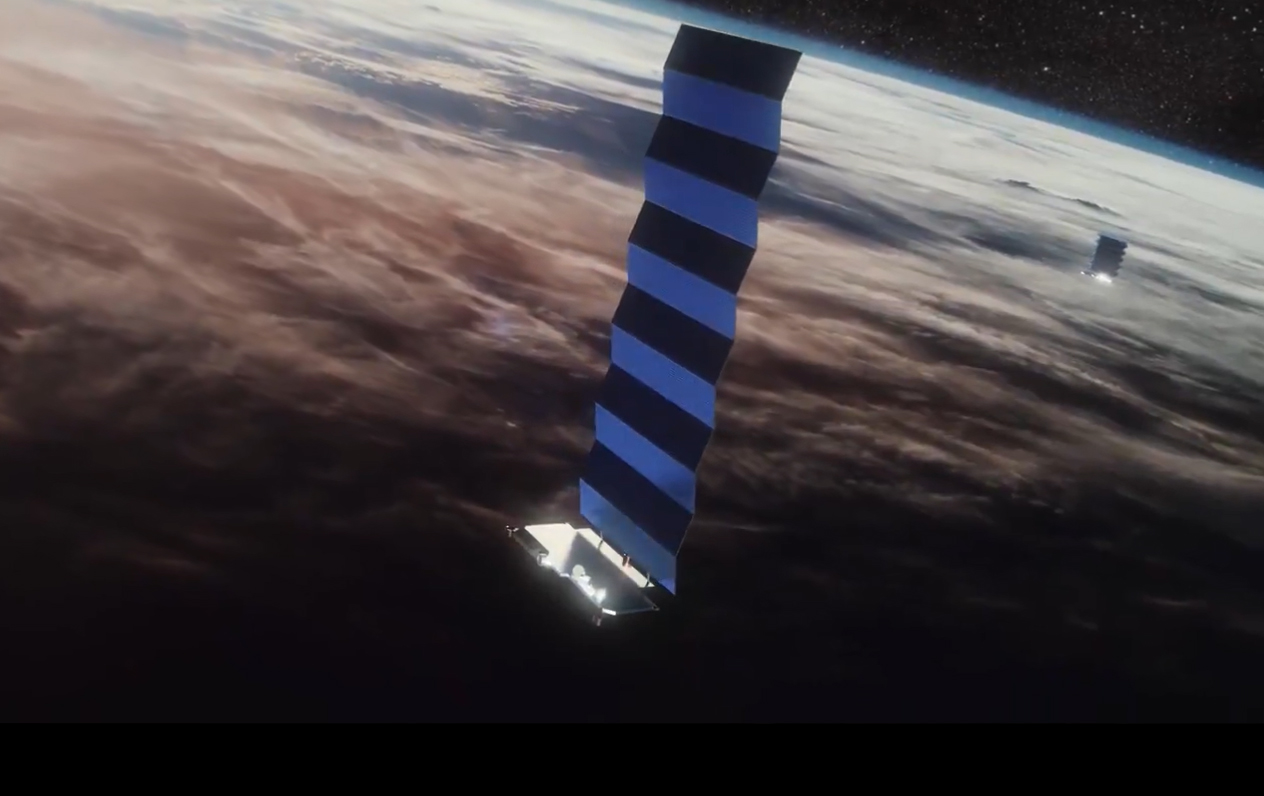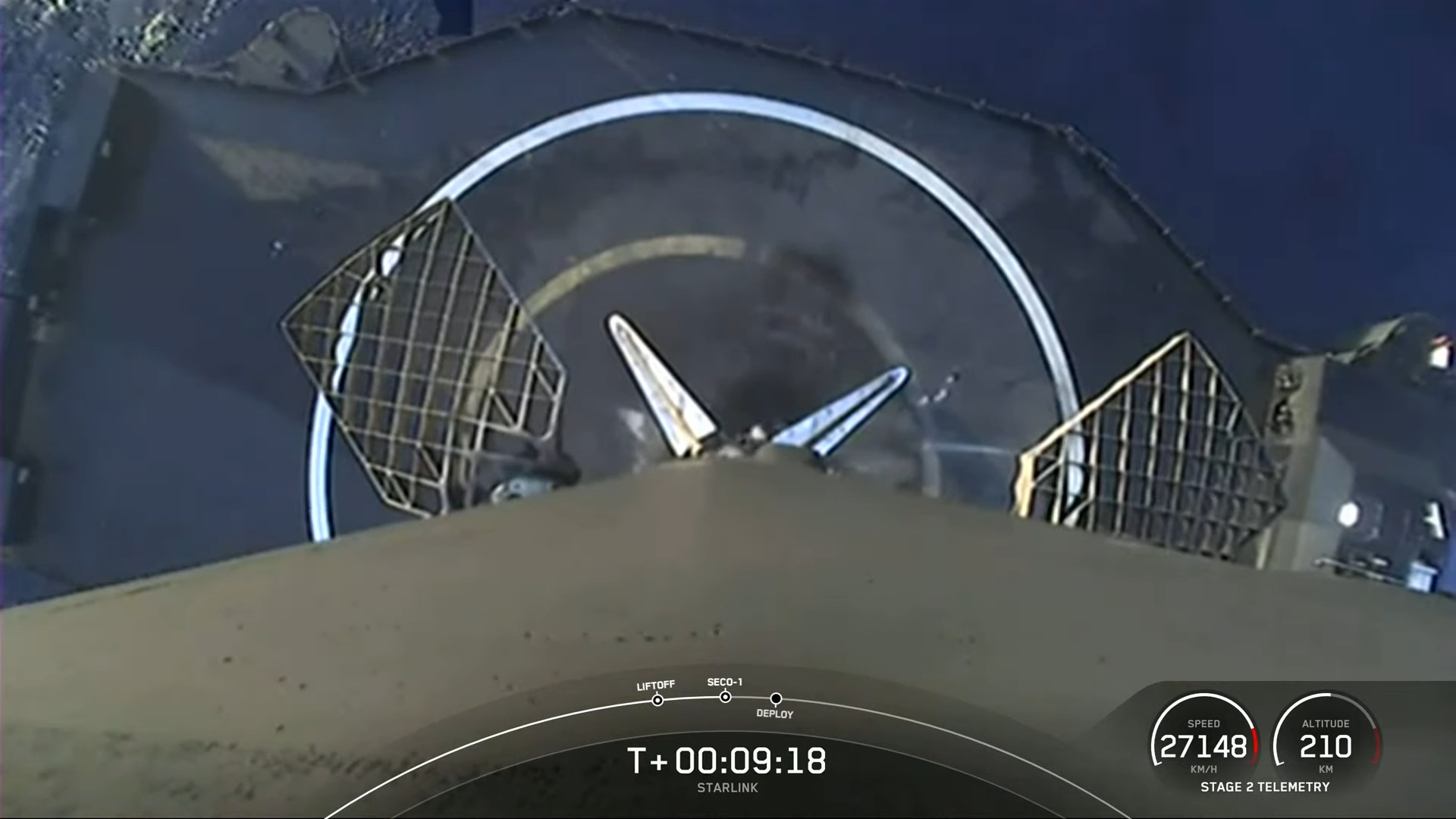SpaceX lofts 49 Starlink internet satellites to orbit in 1st launch of 2022
CAPE CANAVERAL, Fla. — SpaceX successfully launched its first Falcon 9 rocket of the year Thursday (Jan. 6), sending a new stack of Starlink satellites into orbit from Florida, before nailing a landing at sea.
The previously flown Falcon 9 rocket blasted off at 4:49 p.m. EST (2149 GMT) from NASA's Pad 39A at the Kennedy Space Center here in Florida, carrying a stack of 49 Starlink satellites.
Approximately nine minutes after liftoff, the rocket's first stage returned to Earth and touched down on the deck of SpaceX's newest drone ship, "A Shortfall of Gravitas," marking the company's first successful launch and landing of the new year.
"Falcon 9 has successfully lifted off from Launch Complex 39 at Kennedy Space Center, carrying our stack of 49 Starlink satellites to low Earth orbit," SpaceX engineer Jessie Anderson said during the launch broadcast.
Related: SpaceX's Starlink satellite megaconstellation launches in photos
Weather forecasters at the 45th Space Delta predicted ideal weather conditions for liftoff, and Mother Nature did not disappoint. It was a crystal clear day here in Florida and the rocket could be seen throughout its climb through the atmosphere, disappearing from sight when its first stage separated and began the trek back to Earth.
SpaceX confirmed the successful deployment of the 49 Starlink satellites via Twitter about 1 hour, 20 minutes after liftoff.
Get the Space.com Newsletter
Breaking space news, the latest updates on rocket launches, skywatching events and more!

Thursday's liftoff kicks off another action-packed year for the California-based aerospace company. In 2021, SpaceX set a new record for most launches in a single year at 31. The company also launched a total of 12 astronauts on three Crew Dragon missions, including four private citizens who flew as part of the Inspiration4 mission.
SpaceX will try to keep up its rapid launch cadence this year as the company continues to expand its ever-growing internet constellation. Also on deck this month is the company's third dedicated rideshare mission, which is devoted to launching a multitude of small satellites in orbit.
Following that launch on Jan. 13, the company will also send a radar reconnaissance satellite into space for the Italian space agency. Called COSMO-SkyMed Second Generation (CSG 2), the satellite is scheduled to launch on Jan. 24.
The constellation grows

Thursday's flight continues SpaceX's efforts to expand and upgrade its burgeoning Starlink internet constellation, marking the 35th dedicated Starlink launch since 2019. This launch brings the total number of the flat-paneled Starlink satellites up to almost 2,000.
It also continues the company's efforts to launch newly upgraded satellites. In an effort to enable the satellites to communicate with each other, the company equipped them with special laser links. This way the satellites can communicate more effectively, without having to rely on ground relays.
This launch will also feature a slightly different trajectory than normal, with the rocket flying southeast from the coast of Florida, as opposed to the typical northeast path that recent missions have taken. As such, it will have to fly just north of the Bahamas to avoid flying over any populated areas.
That's because SpaceX is targeting a parking spot a few hundred miles above the Earth, at an inclination of 53.2 degrees — one of five orbital shells that the company is working to fill with roughly 4,400 satellites.
These shells will be located at various altitudes above the planet, between 335 and 348 miles (540 and 560 kilometers) and at orbital inclinations of 53, 53.2, 70, and 97.6 degrees. (The inclination is the angle between the orbital plane and the equator.)
So far, SpaceX has filled the 53-degree shell and is working on the rest. Thursday's launch will fill another spot in the 53.2-degree orbit, but will just take a slightly different route to get there.
Starlink's overarching goal is to connect people around the globe, particularly those in rural and remote areas who have little to no connectivity. To date, the service is fully operational and available in 20 countries, and that number keeps rising. With more than 100,000 subscribers, company officials have said that the program is continuously growing.
Falcon's fourth flight

In 2015, SpaceX changed the rocket game by recovering its first first-stage booster. That success was thanks to a series of upgrades the company provided to its workhorse Falcon 9. Featuring a more robust thermal protection system, titanium grid fins and a more durable interstage (the part that connects the rocket's two stages), the souped-up Falcon 9 rocket we see today is capable of flying many times over.
As such, the company heavily relies on a fleet of used rockets to deliver its many payloads into space. This mission is no different.
Dubbed B1062, the rocket featured in Thursday's flight now has five successful missions under its belt. It first debuted in November 2020 when it carried an upgraded GPS III satellite into space for the U.S. Space Force. That mission marked the second time that SpaceX was allowed to recover a booster after launching a payload for the U.S. government. The previous GPS III launch, which occurred in June 2020, marked the first-ever recovery as part of a government mission.
It would go on to also become the first to fly a second government payload as just seven months later, the rocket carried its second GPS III satellite into orbit. Following that successful liftoff, the rocket launched SpaceX's first private astronaut mission: Inspiration4.
The flight was part of a massive fundraising effort for St. Children Research Hospital. As part of that historic mission, four private citizens — Jared Isaacman, Hayley Arceneaux, Sian Proctor and Chris Sembrowski — boarded a Crew Dragon spacecraft and spent three days orbiting the Earth.
Four its fourth act, the same booster ferried a stack of SpaceX's own internet satellites into orbit before returning to Earth and landing on a floating platform at sea Thursday evening.
"A Shortfall of Gravitas" is SpaceX's newest drone ship. The highly-anticipated ship was added to SpaceX's fleet in 2021, bringing the total number of drone ships up to three. These massive ships are crucial components in SpaceX's grand scheme of reusability and ultimately enable them to fly more rockets.
Prior to its arrival in Port Canaveral, the company's most prolific ship, "Of Course I Still Love You" switched coasts, traveling to California so that rockets launching from SpaceX's West Coast facilities would have more options for landing.
There are two ways SpaceX recovers rockets: by landing them on a floating platform at sea, or by returning to land and touching down on a designated landing pad. Landings on terra firma require more fuel, so SpaceX typically opts to land its rockets on the drone ships, ensuring more successful recoveries as not every mission has the excess fuel needed to return to land.
Correction: An earlier version of this story misstated the launch site for this Starlink mission. It launched from NASA's Kennedy Space Center Launch Complex 39A, not the nearby Cape Canaveral Space Force Station's Launch Complex 40.
Follow Amy Thompson on Twitter @astrogingersnap. Follow us on Twitter @Spacedotcom or Facebook.
Join our Space Forums to keep talking space on the latest missions, night sky and more! And if you have a news tip, correction or comment, let us know at: community@space.com.

Amy Thompson is a Florida-based space and science journalist, who joined Space.com as a contributing writer in 2015. She's passionate about all things space and is a huge science and science-fiction geek. Star Wars is her favorite fandom, with that sassy little droid, R2D2 being her favorite. She studied science at the University of Florida, earning a degree in microbiology. Her work has also been published in Newsweek, VICE, Smithsonian, and many more. Now she chases rockets, writing about launches, commercial space, space station science, and everything in between.









